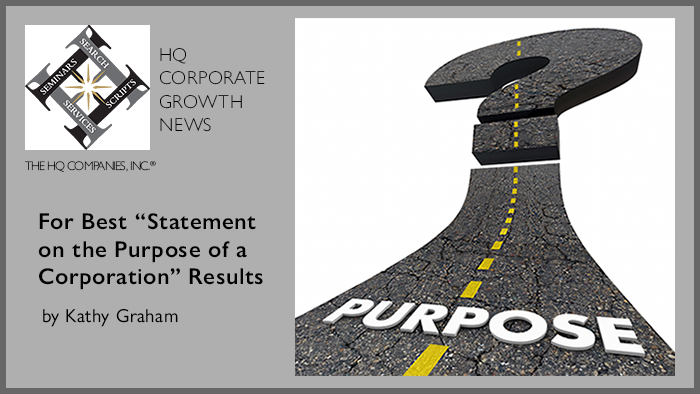In addition to the UN-backed PRI, the SSEI, and other groups, proxy advisor firms are assessing/assigning ESG and HCM levels to U.S. public corporations in response to The Business Roundtable recently issuing a “Statement on the Purpose of a Corporation, which supersedes previous Business Roundtable statements and more accurately reflects our commitment to a free market economy that serves all Americans."1
The Business Roundtable, a nonprofit association founded in 1972 for CEOs of major U.S. companies, has periodically issued Principles of Corporate Governance that since 1997 have stated corporations exist principally to serve their shareholders.
“The new statement is a significant departure from the past in that it includes serving all ‘stakeholders,’ including customers, employees, suppliers, communities, the environment, and shareholders. The prior statement [for the last 22 years] only included shareholders,” states Don Delves and Ryan Resch in a Willis Towers Watson article, “Stakeholder capitalism, executive compensation and corporate governance.”2
“The concept that a corporation should deliver value to all of its stakeholders including the broader community is not new,” continues Delves and Resch in this excellent article. “In fact, much of what the Business Roundtable is stating is in line with what many investors and investment managers have already been saying...The Business Roundtable statement follows other groundbreaking statements by investors and fund managers about the importance of companies having a social mission or reason for existing beyond making money. Increasingly, investors are interested in how companies score on various environmental, social and governance (ESG) measures, including human capital management (HCM).”
Questions that come to mind are:
- Can having a clearly defined and communicated “Statement on the Purpose of a Corporation” for all corporations have the same mixture of ESG and HCM factors defined for each company? Will there be companies that might have some unintended negative consequences from the assigned ESG and HCM levels? What about when competing stakeholder(s) interests occur?
Kate Ashford’s Forbes article “Pros and Cons of ESG Funds”3 and Expert Investor Europe4 note, in ESG investing, “performance isn’t a slam dunk, isn’t a one-size-fits-all,” and can “all too often [have] negative impacts.”
“ESG investing is based on the assumption that ESG factors have financial relevance,” says Georg Kell in his Forbes article “The Remarkable Rise of ESG,” so a choice/conflict between shareholder returns and other stakeholders’ interests is a highly likely to occur event. - Is it known how frequently the optimal ESG and HCM levels change or do they always remain the same for all companies/industries? Are the factors creating the stability or changes in optimal ESG and HCM levels identified and their mechanisms understood?
Delves and Resch ask other great questions in their article that should be considered now, questions such as:
- “How will success be defined?”
- “What committee will be responsible for which stakeholder group?”
- “What data will need to be reviewed and how often?”
- “What new information will be shared with investors and the public about a company’s commitment to, and results with each of their stakeholders?”
- “What are the implications for executive compensation, which are currently based on a heavily shareholder-centric model?” How will those changes be incorporated and in what time sequence?
In their article, Delves and Resch provide possible answers that they at Willis Towers Watson have used in working with major corporations, private and public, domestic and global, and with family-owned corporations, which long have had other stakeholders in addition to a shareholder orientation.
Having all stakeholders’ interests be part of an overarching “Statement on the Purpose of a Corporation” sounds like a great idea and is of interest to public company investors. However, care needs to be taken in implementing at the company management level this investment idea so desired results are the same as actual results. Having further discussions now around such questions as contained in this article will solidify the success of ESG and HCM levels applied to public companies by best aligning investors’ interests with company management.
_________________________
1 https://www.businessroundtable.org/business-roundtable-redefines-the-purpose-of-a-corporation-to-promote-an-economy-that-serves-all-americans.
2 “Stakeholder capitalism, executive compensation and corporate governance,” Don Delves and Ryan Resch, September 13, 2019, Willis Towers Watson, https://www.willistowerswatson.com.
3 “Pros And Cons Of ESG Funds,” Kate Ashford, April 10, 2019, Forbes, https://www.forbes.com.
4 “ESG investing often has ‘hidden negative impacts,” November 30, 2018, https://expertinvestoreurope.com.

